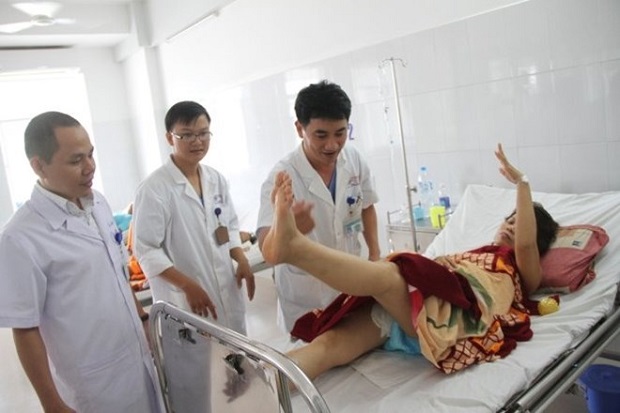Hospital task force saves stroke survivors
Hundreds of stroke victims hospitalised in the Da Nang General Hospital over the past 3 years were saved by a special task force for stroke victims, the Tuoi Tre (Youth) Newspaper reported.
 |
| Doctors examine a stroke victim. (Source: Tuoi Tre) |
The task force examines anyone arriving at the hospital with symptoms of a stroke, and gives first aid.
The patient is then classified as an “urgent case”, enabling a speeded up administrative process so doctors can race to save the patient’s life, the hospital’s Director Dr Tran Ngoc Thanh told the newspaper.
Proper first aid is essential, the doctor said.
Experience shows that the first 3 hours after a stroke are the crucial ones for getting life-saving treatment, but most victims arrive at the hospital after experiencing the symptoms, such as numbness, difficulty speaking and vertigo, he added.
According to the hospital director, the task force was formed three years ago and consists of 10 doctors.
“The whole process of diagnosing, giving first aid, conducting tests and deciding on proper treatment will take about 40-60 minutes,” said doctor Duong Quang Hai, one of the team members.
If they are treated in time, “most stroke patients resume normal lives after one month of treatment in the hospital,” Hai said.
“We are always racing against time because every minute that passes reduces the patient’s chances of survival,” he said.
The doctors have also instituted several new treatment methods for stroke patients.
“Before, about 70-80% of patients with a stroke caused by a blood clot in brain vessels would die or remain disabled,” said doctor Le Duc Nhan.
“Since earlier this year, the hospital has a new method of removing blood clots from the brain vessels,” Nhan said, “giving many patients a chance of survival.”
According to the Viet Nam Stroke Association, about 200,000 people in Viet Nam suffer strokes each year. Half die, a decrease of about 20% compared with 10 years ago.
Experts say stroke treatment in the country is difficult due to limited hospital infrastructure and lack of knowledge on the part of victims.
While the number of deaths has dropped, the number of those remaining disabled was on the rise.
In fact, about 90% of patients suffer after effects, the severity of which depends on when they were hospitalised and how they were treated.
The Da Nang General Hospital is one of ten hospitals nationwide providing emergency intervention and treatment for strokes. But most hospitals nationwide still lack modern equipment for diagnosis and treatment.
(Source: VNA)